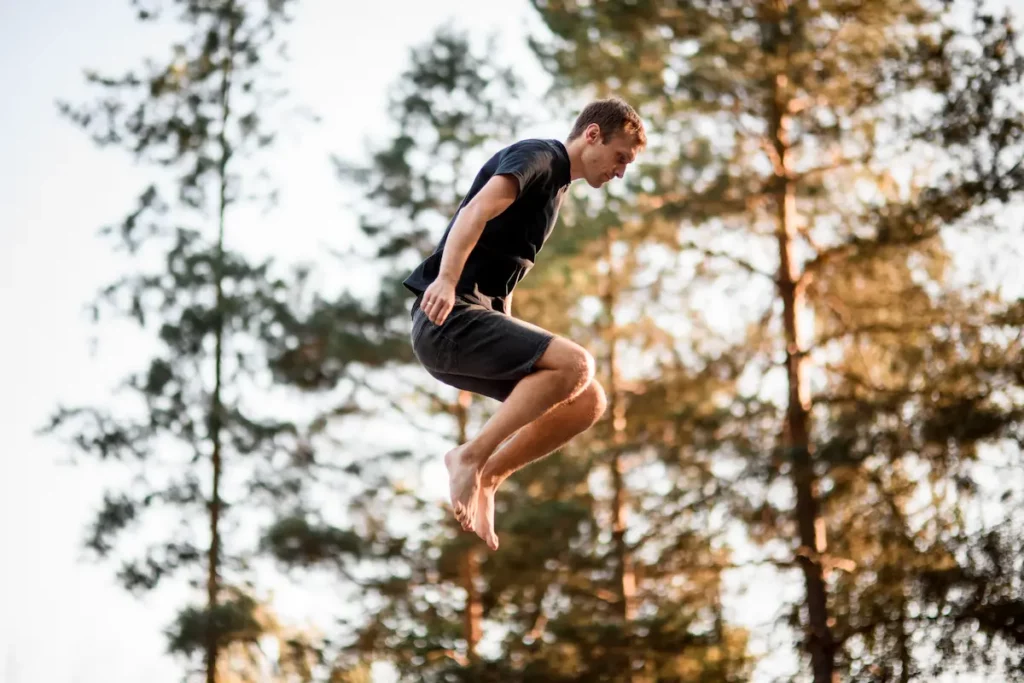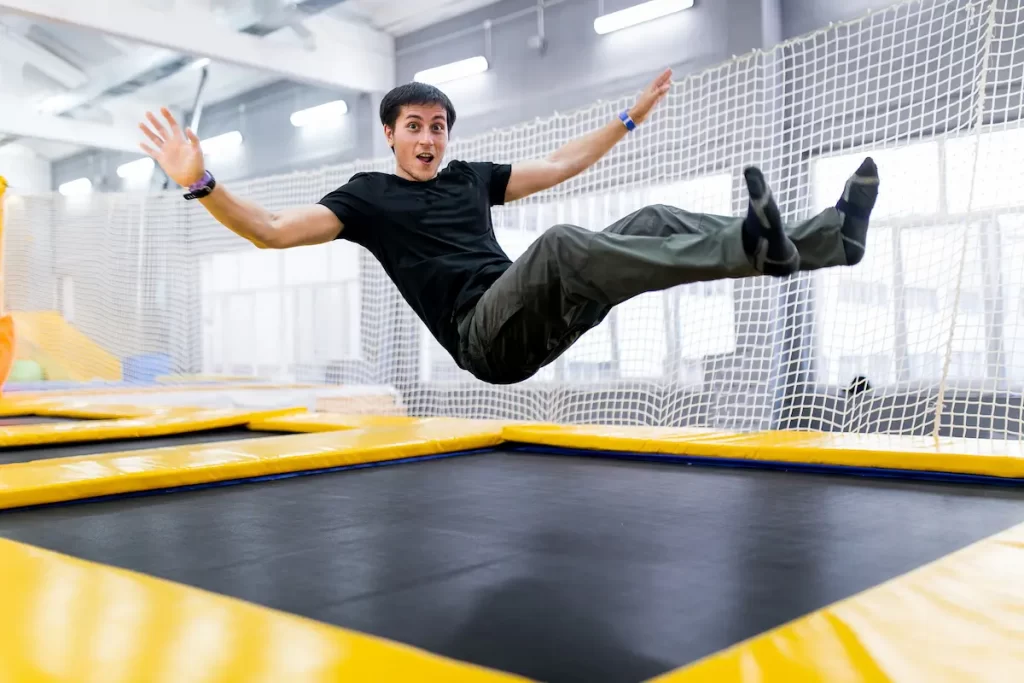There is debate as to whether jumping on a trampoline increases bone density. Studies have been limited in looking at this health aspect. However, there does appear to be evidence that exercises on a trampoline have a positive effect on bones.
Time spent bouncing on a trampoline is fun. Yet, there are other benefits than merely an enjoyable activity. It is a great overall workout for your muscles and body. But what about improving bone density?
People who have osteoporosis can benefit from jumping on a trampoline. But the advantages of such exercise are available to everyone. Keep reading to find out how bouncing on a trampoline can improve bone density.

Related Reading: Will Jumping on a Trampoline Help You Lose Weight? [ANSWERED]
What is bone density?
Density can refer to how solid something is.
Our bones are in a constant state of change. Osteoblasts act as constructors, adding new pieces to our bones. The old pieces are taken away by osteoclasts.
As we grow older the number of bone pieces being added decreases. The result is the solidity (density) of our bones is weakened.
The inner parts of our bone structure are protected from bumps and knocks by the outer cortical bone. When the cortical bone is compromised you are more susceptible to damaging your bones through falls.
Osteoporosis
Osteoporosis is a health issue that some postmenopausal women face.
As the hormonal balance changes, the amount of estrogen being produced decreases. Due to this, bone tissue isn’t being regenerated and bone density drops.
A thinner bone structure means that one has a higher chance of fractures or broken bones. This is something that women with osteoporosis fear.
Yet, it is possible to build up bone density. The most popular way to do so is through rebounding.
What is rebounding?
Rebounding is a physical activity in which you jump on a small trampoline.
Your feet can remain on the surface of the trampoline as you lightly bounce. Otherwise make small leaps in the air about six inches off the trampoline.
You can do this exercise for 15 minutes a day.
How does rebounding build bone density?
Bones become stronger when placed under stress. This principle is what makes rebounding such an effective way to increase bone density.
When you jump, gravity pulls you back down towards the trampoline. It’s this force that strengthens your bones and muscles.
The impact of landing on the trampoline’s surface puts stress on your legs.
Then you have to push yourself up as you jump, which adds more stress to your bones and muscles.
It’s this process of putting physical demands on your body that helps build bone density.
Rebounding exercises to build bone density
If you’re keen to have a go working with a rebounder, here are several exercises.
These are all low intensity to not cause you any injuries. However, always approach exercising with caution and seek professional medical advice first.
Aerobic Bounces
Add some innovation to your jumps: Do small star jumps, hopping, twists, or running on the spot.
Don’t feel like you have to rush through your routine. Take your time.
Subtle bouncing
In this activity, you aren’t jumping. You merely let yourself bounce while having both feet stay on the trampoline.
The gentle motion will help strengthen your bones as well as improve your circulation.
Jumps
This exercise requires you to jump as high as you can, but stay safe! It is an all-rounder workout that builds up your bone density, strengthens your muscles, and boosts your lymphatic system.
If jumping is hard for you to do, make it a goal to progress up to this level.
How many jumps are too many?
When you do rebounding exercises there is a strain you’re putting on your body. The amount and level of this may have adverse effects on your health. This is opposite to what you’re trying to achieve.
That isn’t to say you can’t do trampoline exercise. It’s simply a matter of approaching the activity with care and awareness about your current capability.
With that in mind, there is an ideal number of repetitions that maximize the benefit of your workout. Anywhere between 10 to 20 repetitions will increase your bone density and muscle mass.
Beyond 20 repetitions, the effectiveness of the exercise drops away.
That doesn’t mean you should stop after the maximum number of repetitions. Keep jumping if you want to.
If you have balance issues, you can get rebounders with side grip handles. These allow you to remain stable as you strengthen your bones.
When you should avoid using a rebounder
Rebounding exercises aren’t for everyone.
Those of you who have a fractured or compressed spine should look at alternative methods for increasing your bone density.
Using a rebounder when you have these health situations will only aggravate the problem.

Other methods for building bone density
As we mentioned in the last section, there are ways to strengthen your bones without a trampoline.
When choosing one of the following activities, age can play a factor due to the body’s decreasing supply of osteoclasts as we get older.
Here is a list of recommended exercises for developing bone density:
- Aerobics: Let your body feel the strain as this is what aids in development.
- Playing tennis: As you run around the court, the impact of your feet against the turf will help build up your bones.
- Dancing: The movement and aerobics will strengthen your entire body as well as improve your circulation.
- Resistance training: Another style of exercise that puts stress and strain on your muscles and bones. For older adults, you can use resistance bands instead of weights.
- Walking: A low-impact activity that still gives your bones what they need to become denser. That’s due to the forces being transferred from the ground up into your feet and legs.
- Hiking: If you enjoy the outdoors, hiking provides the benefit of walking with an amazing day out in nature. The changing terrain you experience with hiking offers great resistance that your bones and muscles need.
- Climbing stairs: A set of stairs can offer great resistance. This is because you are pushing your body upward while gravity is trying to pull you down. Your body load is being transferred from one foot to the other and this helps your bones become denser.
- Skipping: There are many health benefits to using a skipping rope. It’s a whole-body exercise. As you land, stress is being put on your bones and they grow thicker.
- Clean up your property: You can increase your bone density by pushing a lawnmower around or doing heavy-duty yard work. The pressure and resistance you experience are good for your bones.
Use supplements
You can improve your bone health by using supplements. Vitamin K, D, and calcium are your best choice.
Your bones are more likely to break when you’re not getting enough calcium in your diet. You can easily rectify this by eating more dairy products or taking calcium tablets.
A lack of Vitamin K leads to less dense bones. That makes you more susceptible to fractures. Add more greens to your diet such as broccoli or spinach.
Vitamin D aids in your body’s absorption of calcium. It also strengthens your muscles.
Milk and eggs are great sources of vitamin D. If you love fish, then eat some salmon.
If changing your diet seems too hard, you can go to your local pharmacy or natural health food shop and buy Vitamin K and Vitamin D supplements.
Conclusion
As we get older our bones can become weaker. Yet, you can increase bone density with activities that put stress on your bones and muscles.
Exercising on a trampoline is one way to strengthen your bones and make them denser.
Yet, people who have back problems or balancing issues can struggle with jumping on a trampoline. There are other ways to build up your bones such as walking, dancing, or doing resistance training.
Add calcium and vitamin supplements into your diet to give your body an added boost.
